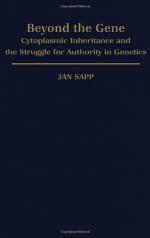|
This section contains 683 words (approx. 3 pages at 300 words per page) |

|
In the nineteenth century, biologist Gregor Mendel established patterns of heredity in sexually reproducing organisms on the basis of equal genetic contributions from both parents. It is now known, however, that there are exceptions to Mendel's laws, and that DNA other than that contained in the nucleus of the gametes can influence the characteristics of the offspring.
Both the chloroplasts of photosynthetic organisms and the mitochondria of all eukaryotic organisms contain their own genomes. The small number of genes in these organelles code for tRNAs, rRNAs, and proteins used in photosynthesis and oxidative phosphorylation, respectively. These genes are inherited independent of the nuclear genes, and are contributed almost exclusively by the maternal gamete, or egg. One of the earliest observations of this maternal inheritance in plants was in the four o'clock flower, Mirabilis jalapa, in which the leaf color depends solely on that of the plant...
|
This section contains 683 words (approx. 3 pages at 300 words per page) |

|


